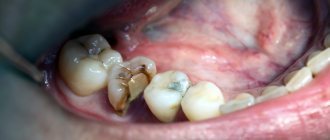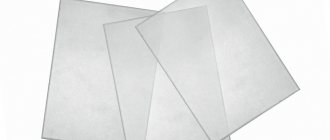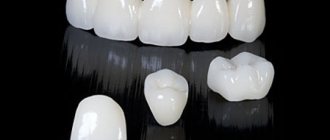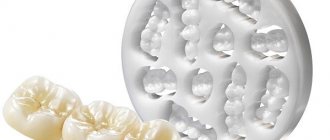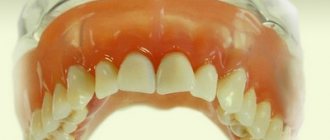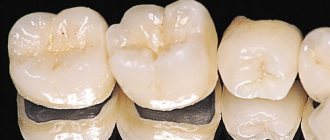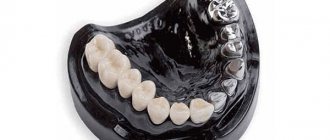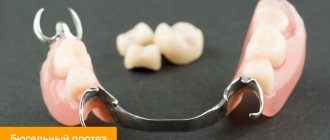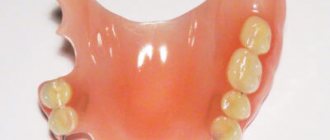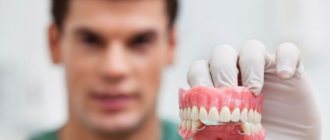Indications Installation on your teeth Materials Installation on implants What to do if the crown comes off?
How important is fixation of the tooth crown and what types of fixation are used?
In modern dentistry, preserving natural teeth is considered the most important task. For this purpose, various therapeutic and even surgical treatment methods are used. The installation of artificial crowns can be an independent method, for example, if pathological abrasion of the enamel is observed, or as part of treatment. This happens during endodontic intervention. The pulp (nerve) is removed from the tooth, it becomes brittle, and a crown is used to protect the tooth from destruction.
Indications
Indications for restoration:
- significant destruction of the coronal part;
- installation of bridges;
- pathological abrasion of enamel;
- depulpation;
- injuries.
Crowns are made of metal, ceramics and metal-ceramics. Porcelain and plastic crowns are practically not used due to their fragility. Modern materials are particularly durable and wear-resistant. They are designed for long-term use. But the service life, as well as the convenience of the crown, also depends on how well it fits and how firmly it is secured.
Fixation of dental crowns
At certain stages of orthopedic treatment there is a need to use temporary crowns. In such cases, temporary fixation of crowns with special cement or artificial resin is used. The main feature of these materials is that the temporary structure can be removed without difficulty. Adhesive materials are easy to clean and leave no residue.
There are two types of permanent fixation of crowns in dentistry: cement and screw. With the development of implantology, they began to separate fixation on their teeth and on implants.
Installing a crown on your teeth
No matter how badly a tooth is damaged, as long as it has a root, it can be restored. How exactly the restoration is carried out depends on the degree of tooth decay. In case of minor damage, the unit is prepared - the top layer equal to the thickness of the crown is removed. Metal-ceramic crowns consist of 2 layers: metal and ceramic, so they require the deepest preparation. Ceramic crowns are thinner and remove a small layer of hard tissue. Zirconium crowns are thin and require minimal layer removal.
If the upper part is destroyed by 50% or more, then the crown is fixed with a pin. A fiberglass rod is inserted into the canal to serve as a support for the restoration.
Stages
After preparing the surface, the orthopedist makes an impression of the jaws, from which a crown is stamped or cast in the laboratory. Manufacturing takes several days. Before installing the structure, they carry out fittings - check how it fits and whether there are any defects. The crown may be too wide, narrow, or high. Fitting helps to notice shortcomings and eliminate them.
The restoration is first placed with temporary cement. The patient is given the opportunity to get used to a foreign object in the mouth, to understand whether the height is disturbing or whether the edge is cutting the gum. Only after this the structure is installed on permanent cement.
- Before fixation, the crown is treated with a special solution, degreased and dried.
- Next, the tooth is treated with an antiseptic, and the remaining moisture is removed with ether or air. In some cases, gum retraction is performed with a thread to clearly mark the junction of the artificial crown and hard tissue.
- The components for cement are mixed on a sterile plate.
- A thin layer of cement is placed inside the restoration and placed over the tooth.
- Excess is removed. The patient is asked to sit with his teeth closed. Then clean the surfaces again and rinse your mouth with a special solution. This completes the orthopedist’s work.
Why is it important to install temporary crowns?
Beauty is what is on the surface. Therefore, patients are often interested in whether temporary crowns are placed on implants just to see a presentable reflection in the mirror.
These systems perform additional functions:
- They form a gum contour that is close to natural. This task is especially relevant for the frontal region.
- Provide a physiological relationship between the crown and gum. They guarantee the presence of load on soft and hard tissues.
- They maintain the sterility of wound areas, protecting them from the constant ingress of foreign microflora.
Installation can be done by a direct method - this is the application of materials in layers directly to the pin in the oral cavity.
Or indirect. The second includes the rapid production of temporary crowns from metal-free masses using computer modeling. The program calculates all the characteristics of the future crown and produces it in a special chamber. Thanks to CEREC technology, no additional fittings are needed. The crown is immediately fixed on the titanium root. It is rational to install screw crowns on implants, but it is also possible on a budget using cement.
Make an appointment with me for a consultation, come and see: installing a temporary or permanent crown on an implant is painless, quick and easy for the patient. Minimum discomfort and time.
Materials for fixing crowns
Cement for fastening restorations must perform 2 main functions: securely fix the crown and fill the microgaps between it and the dentin. Several types of fixing materials are used in dentistry:
- Glass ionomer cements
(GIC). They are good because they have anti-caries properties and are not afraid of micro-leaks. Used for structures made of metal, with a metal base and ceramic. - Glass ionomer cements modified with composite
(GICMC). Easy to use and very durable, such materials are used for restorations made of metal, zirconium, and lithium disilicate. - Composite
. The most modern materials. They produce cements that harden as a result of a chemical reaction, light radiation and double curing. Suitable for fixing metal-ceramic, zirconium, ceramic, and lithium disilicate crowns.
All these groups are divided into numerous subgroups and the doctor selects the material for fastening based on the geometry of the tooth, crown material, and clinical case.
Dental cements have been used for a long time, they are well studied, application methods have been worked out and are simple in nature. These materials reliably fix restorations and can serve for a long time.
The disadvantages of cements are that mixing is done by hand and errors in proportions are possible. This leads to de-cementing. Excess acids negatively affect the condition of dentin.
How to install an artificial crown on cement
As part of the general algorithm for prosthetics, fixation is the final stage, and provides for the following procedure:
- The prepared abutment is sandblasted with an abrasive machine, resulting in a rough surface.
- The crown, prepared in advance on the basis of an anatomical cast, is tried on the base, excluding discrepancies in fit.
- An adhesive composition is applied to the inner surface of the prosthesis, after which the product is tightly applied to the abutment.
- The finished structure is irradiated with a special lamp, which accelerates the intensity of polymerization of the fixing layer.
- Excess cement that appears during pressing of the crown is carefully removed from the surface.
Loading of the restored unit is allowed within an hour after the procedure, however, on the first day after surgery it is recommended to avoid excessive pressure on the area.
Advantages and disadvantages of technology
The positive aspects that determine the popularity of the technique include:
- There is no need to form an additional hole, which reduces the aesthetics of the finished prosthesis, which is especially important when prosthetics of frontal units;
- Possibility of correcting the fit of the superstructure - flaws in carelessly performed implantation are leveled out by cement fixation, which ensures the correct position of the crown even with axial deviation of the integrated rod;
- The option of primary fitting outside the oral cavity, which increases the accuracy of the connection and eliminates the development of inflammatory processes;
- Maintaining the strength of the connection in the long term.
The only drawback of the technology is the difficulty of dismantling the crown if new problems arise with the restored area. Fitting with cement will require re-manufacturing of the prosthesis, since removing the previous one without disturbing the original configuration is not possible.
Prosthetics on implants
Crowns are secured to implants in 2 ways: with cement or a screw
. This depends, first of all, on the type of implantation and the implant models that are used. But anatomical features and clinical manifestations play a big role.
Cement fixation of crowns on implants has its pros and cons. The process of attaching a restoration to an implant using cement is not much different from prosthetics on natural teeth. It is simple, well studied, and allows fixation in complex cases where a screw fixation would require enormous effort and skill.
The disadvantages include the possibility of peri-implantitis, which can be caused by excess cement. When using cement, the crown cannot be repaired, only replaced.
Screw fixation of crowns to the implant prevents cement from getting on the tissue. There is a possibility of repair and correction. The results of joining metal to metal without a cement layer are better. The single design of abutment and crown reduces the risk of infection.
However, the fitting of a screw-fixed prosthesis is more delicate, requires certain skills, and the price of designs with screws is higher.
This is why choosing a doctor is so important. A qualified implantologist takes into account dozens of details before choosing an implantation method, which determines whether the crown will be screw-fixed or cemented, and an experienced orthopedist knows how to work with both.
Advantages and disadvantages
The demand for GIC in dentistry is due to a number of objective advantages, which include:
- High adhesiveness when interacting with the structure of dental tissue. The material does not require pre-etching with acid, and is effective even if moisture is maintained in the preparation area.
- Strong connection with composite materials used for filling;
- Long-term preservation of anti-corrosion activity due to the fluoride content;
- Formation of an elastic structure that can withstand mechanical loads arising during chewing;
- Thermal expansion close to the dental tissue, eliminating the possibility of violation of the marginal seal.
Among the shortcomings noted by experts, it is worth highlighting:
- Sensitivity to moisture during polymerization - contact with liquid reduces the content of aluminum ions, disrupting the structure of the cement composition;
- Failures in the hardening process due to excessive dryness, the consequences of which are increased sensitivity in the postoperative period;
- Vulnerability to mechanical stress during curing, not only to traditional load, but also to vibration that occurs when using a drill.
However, similar disadvantages are also characteristic of other cement compositions, including those that cannot provide the indicated advantages.
Mode of application
The use of glass ionomer cement when installing artificial crowns depends on the material of their manufacture, and requires compliance with the protocol. The process involves three successive stages:
- Preliminary preparation of the tooth - preparation, washing, drying and swab treatment;
- Mixing cement - combining the specified proportions of powder and liquid;
- Fixation of an artificial crown - applying a layer of cement to the base and planting the replacement structure with moderate pressure.
It is important to note that, depending on the brand of cement used, the working time with the composition changes, as well as the temperature conditions that ensure its optimal characteristics. Increasing the temperature reduces the setting time. It is recommended to take care in advance to maintain the thermal level. Polymerization of the composition occurs gradually - at the moment when the cement structure acquires the characteristic “rubber” effect, excess should be removed from the working surface.
Glass ionomer cements are biologically compatible with dental tissue and, as a rule, do not cause allergic reactions in patients. If side effects are detected, it is recommended to immediately contact the clinic for a re-examination.
